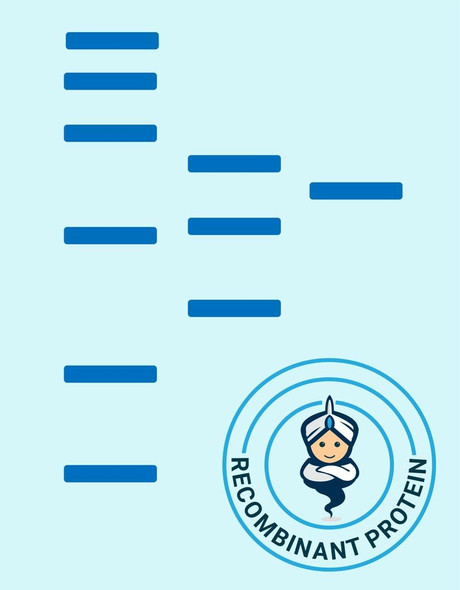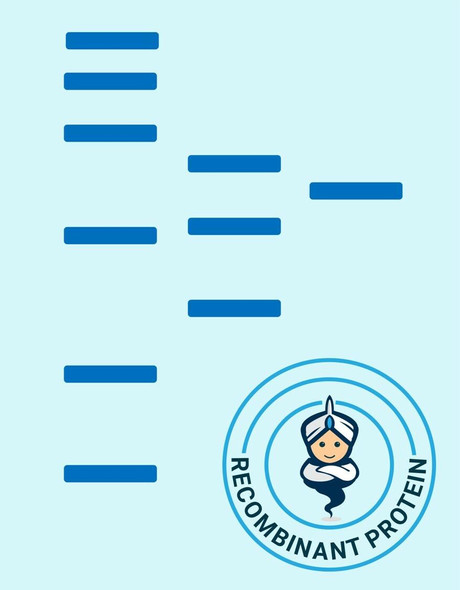Description
| Product Name: | Human Frataxin Recombinant Protein |
| Product Code: | RPPB3555 |
| Size: | 25µg |
| Species: | Human |
| Target: | Frataxin |
| Synonyms: | FXN, Friedreich ataxia protein, Frataxin mitochondrial, FRDA, X25, FA, CyaY, FARR, MGC57199, Frataxin. |
| Source: | Escherichia Coli |
| Physical Appearance: | Sterile Filtered colorless solution. |
| Formulation: | The Frataxin solution contains 20mM Tris-HCl buffer (pH 8.0), 1mM DTT and 10% glycerol. |
| Stability: | Store at 4°C if entire vial will be used within 2-4 weeks. Store, frozen at -20°C for longer periods of time. For long term storage it is recommended to add a carrier protein (0.1% HSA or BSA).Avoid multiple freeze-thaw cycles. |
| Purity: | Greater than 95.0% as determined by SDS-PAGE. |
| Amino Acid Sequence: | MGSSHHHHHH SSGLVPRGSH MLRTDIDATC TPRRASSNQR GLNQIWNVKK QSVYLMNLRK SGTLGHPGSL DETTYERLAE ETLDSLAEFF EDLADKPYTF EDYDVSFGSG VLTVKLGGDL GTYVINKQTP NKQIWLSSPS SGPKRYDWTG KNWVYSHDGV SLHELLAAEL TKALKTKLDL SSLAYSGKDA |
Frataxin is a mitochondrial iron binding protein that is part of the FRATAXIN family.Frataxin functions in regulating mitochondrial iron transport and respiration. The expansion of intronic trinucleotide repeat GAA results in Friedreich ataxia. Frataxin plays a role in iron homeostasis. Frataxin is an anti-apoptotic protein which prevents mitochondrial damage and reactive oxygen species (ROS) production.
Frataxin Human Recombinant produced in E.Coli is a single, non-glycosylated, polypeptide chain containing 190 amino acids (42-210 a.a.) and having a molecular mass of 21.1 kDa.The Frataxin is fused to a 20 amino acid His Tag at N-terminus and purified by proprietary chromatographic techniques.
| UniProt Protein Function: | FXN: Promotes the biosynthesis of heme and assembly and repair of iron-sulfur clusters by delivering Fe(2+) to proteins involved in these pathways. May play a role in the protection against iron-catalyzed oxidative stress through its ability to catalyze the oxidation of Fe(2+) to Fe(3+); the oligomeric form but not the monomeric form has in vitro ferroxidase activity. May be able to store large amounts of iron in the form of a ferrihydrite mineral by oligomerization; however, the physiological relevance is unsure as reports are conflicting and the function has only been shown using heterologous overexpression systems. Modulates the RNA-binding activity of ACO1. Defects in FXN are the cause of Friedreich ataxia (FRDA). FRDA is an autosomal recessive, progressive degenerative disease characterized by neurodegeneration and cardiomyopathy it is the most common inherited ataxia. The disorder is usually manifest before adolescence and is generally characterized by incoordination of limb movements, dysarthria, nystagmus, diminished or absent tendon reflexes, Babinski sign, impairment of position and vibratory senses, scoliosis, pes cavus, and hammer toe. In most patients, FRDA is due to GAA triplet repeat expansions in the first intron of the frataxin gene. But in some cases the disease is due to mutations in the coding region. Belongs to the frataxin family. 2 isoforms of the human protein are produced by alternative splicing. |
| UniProt Protein Details: | Protein type:Motility/polarity/chemotaxis; Mitochondrial; EC 1.16.3.1 Chromosomal Location of Human Ortholog: 9q21.11 Cellular Component: mitochondrion; mitochondrial matrix; cytosol Molecular Function:2 iron, 2 sulfur cluster binding; ferroxidase activity; protein binding; ferric iron binding; ferrous iron binding; iron-sulfur cluster binding Biological Process: mitochondrion organization and biogenesis; negative regulation of multicellular organism growth; cellular iron ion homeostasis; positive regulation of metalloenzyme activity; positive regulation of transferase activity; proprioception; negative regulation of organ growth; positive regulation of cell growth; adult walking behavior; protein autoprocessing; embryonic development ending in birth or egg hatching; iron incorporation into metallo-sulfur cluster; positive regulation of lyase activity; positive regulation of cell proliferation; aerobic respiration; ion transport; response to iron ion; negative regulation of apoptosis; positive regulation of oxidoreductase activity; oxidative phosphorylation; heme biosynthetic process Disease: Friedreich Ataxia 1 |
| NCBI Summary: | This nuclear gene encodes a mitochondrial protein which belongs to the FRATAXIN family. The protein functions in regulating mitochondrial iron transport and respiration. The expansion of intronic trinucleotide repeat GAA from 8-33 repeats to >90 repeats results in Friedreich ataxia. Alternative splicing results in multiple transcript variants. [provided by RefSeq, Jul 2016] |
| UniProt Code: | Q16595 |
| NCBI GenInfo Identifier: | 6166193 |
| NCBI Gene ID: | 2395 |
| NCBI Accession: | Q16595.2 |
| UniProt Related Accession: | Q16595 |
| Molecular Weight: | 23kDa |
| NCBI Full Name: | Frataxin, mitochondrial |
| NCBI Synonym Full Names: | frataxin |
| NCBI Official Symbol: | FXN�� |
| NCBI Official Synonym Symbols: | FA; X25; CyaY; FARR; FRDA�� |
| NCBI Protein Information: | frataxin, mitochondrial |
| UniProt Protein Name: | Frataxin, mitochondrial |
| UniProt Synonym Protein Names: | Friedreich ataxia protein; Fxn |
| UniProt Gene Name: | FXN�� |
| UniProt Entry Name: | FRDA_HUMAN |








